Artillery: John Pelham – Artilleryman, Gallant Fool, Splendid Boy
 Advancing Union troops were convinced a full battery raked their flank as they moved toward the Confederate position at Prospect Hill near Fredericksburg. Multiple Union batteries opened fire from Stafford Heights, trying to drive out the artillerymen delaying General Meade’s progress toward the Rebel lines.
Advancing Union troops were convinced a full battery raked their flank as they moved toward the Confederate position at Prospect Hill near Fredericksburg. Multiple Union batteries opened fire from Stafford Heights, trying to drive out the artillerymen delaying General Meade’s progress toward the Rebel lines.
General Lee occasionally turned his field glasses in the direction of the artillery duel. General Jackson watched the progress and wished for this flank defense in every battle. General Stuart dispatched multiple messengers to the gun’s commander, asking him to withdraw to safety.
At the center of it all – receiving the messages and in Union crossfire – the major directed his artillerymen manning the gun which temporarily stalled a Union corps attack with rapid, enfilading shots. Lying on the ground between duties to try escaping the Union projectiles, the cannoneers swabbed, loaded, and fired while their commander worked alongside them, encouraging, directing, and pitching in to keep the gun firing. Another message arrived from his commander – J.E.B. Stuart – “Get back from destruction, you infernal, gallant fool, John Pelham!”[i]
Who was this “gallant fool” who stalled Union attacks, won the admiration of army commanders, and even praise from his enemies? Just twenty-four, John Pelham probably would not have imagined his life the way it turned out. After-all, according to his neighbors, he was supposed to hang for a crime, and according to the papers he signed in 1856, he was supposed to be a United States Army officer. How did he arrive on the field at Fredericksburg, defending the Confederate right flank?

Born on September 7, 1838, John Pelham was the third son of Dr. Atkinson and Martha McGehee Pelham of Benton County, Alabama. He spent his youth attending local schools, terrorizing the teacher, and playing pranks with his five brothers and sister. The neighbors predict the Pelham boys would hang for crimes because of their wild childhood, but John started studying in his teen years, began running one of the family farms, and eventually applied for West Point. On March 18, 1856, he wrote to Jefferson Davis – secretary of war – accepting cadetship at West Point, and on July 1, he reported to the military academy.
Though his academics stayed mediocre and he racked demerits for minor infractions, Pelham excelled at horsemanship, fencing, boxing, and making friends. One of his classmates – Adelbert Ames – wrote that Pelham was “the kind of man whom you felt instinctively, ‘Here is a friend.’”[ii] His friendships and good sense steered him away from the sectional conflicts espoused and promoted by some cadets as reports from Bloody Kansas and Harpers Ferry rocked the nation and the academy. Pelham stayed busy with his studies, sports, debate club, color guard, and religious activities, hoping to graduate in 1861. (At that time, cadets studied for five years.)
However, national events and his homestate’s choice created a dilemma for Pelham. He wanted to graduate, believed in America and the Constitution, and felt allegiance to his state. When Alabama seceded, Pelham offered his services but waited to leave West Point, desperately hoping conflict might be avoided. “Although I am a most ultra Secessionist, I am still proud of the American Flag,” he wrote to his family, trying to make sense of the situation and what he should do.[iii] In the end, on April 17, 1861, John Pelham became one of the last Southern cadets to resign from West Point; he started his sneaky journey back to Alabama on April 22nd, traveling with his classmate and friend Tom Rosser, a future Confederate cavalry commander.

By May 15, 1861, Pelham received a commission as first lieutenant in the Confederate army with orders to report to Virginia and assist with ordinance. Assigned to Alburtis Battery with Johnston’s army in the Shenandoah Valley, Pelham spent weeks teaching the new recruits how to drill, handle cannon, and prepare for battle while Alburtis, the commander, figured out how to command this new unit. Training seven hours per day paid off when the battery arrived on the battlefield near Manassas in July. Unexpectedly, Alburtis fell ill on the morning of July 21, 1861, leaving command to Lieutenant Pelham who maneuvered the batteries six outdated cannons into position on the far right of “Stonewall” Jackson’s line, near Robinson House. By the end of the fight, Pelham had personally shot down three United States flags with his artillery skill, dueled with Griffin and Ricketts’ Union batteries, maneuvered forward to halt Sherman’s infantry advance, and secured the praise of his superiors. He had also – unknowingly – caught the attention of a Confederate cavalry commander, James Ewell Brown Stuart.
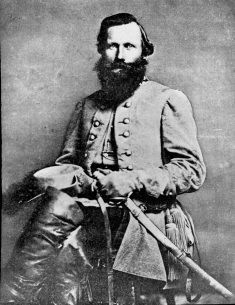
Stuart dreamed of creating a light artillery battery to accompany his cavalry – copying the idea from Napoleon. On November 11, 1861, he got permission to form a light battery; eighteen days later, Confederate Special Orders No. 557 directed John Pelham to report for duty to J.E.B. Stuart. It was the beginning of a relationship which lasted the remainder of these officers’ lives. About five years older than Pelham, Stuart regarded the artilleryman as a younger brother, promoting, teasing, and looking after him in true sibling style. To keep an eye on him and keep him close for immediate deployment, Stuart invited Pelham to lodge and dine at cavalry headquarters, even though he was not an official staff member.
Although Pelham’s promotion to captain did not arrive until May 1862, he set to work immediately, forming this battery of light artillery. He went on a short recruiting tour, enlisting men from across the Confederacy to man his original eight field pieces, which were different weights and styles – whatever was available for service. Through the winter and early spring, Pelham drilled his artillerymen and horses incessantly, developing skills and strategy to fire rapidly, move swiftly, and keep up with the regular cavalry. His skills as an organizer exceeded expectation and throughout his services, he famously kept his ammunition chests full, carriages and gear in repair, and was always on the lookout for new cannons.
The campaigns and battles of 1862 proved Stuart’s innovative idea and Pelham’s organizational skills and leadership were worth the effort. In the Peninsula Campaign and Seven Days Battles, Pelham and his light battery often defended the army’s rear or secured important battlefield points, winning commendation in many military reports. One of the more famous incidents in this period involved an artillery duel with the USS Marblehead near White House Landing; Pelham’s guns fired, moved rapidly, and chased the Union ship down river.
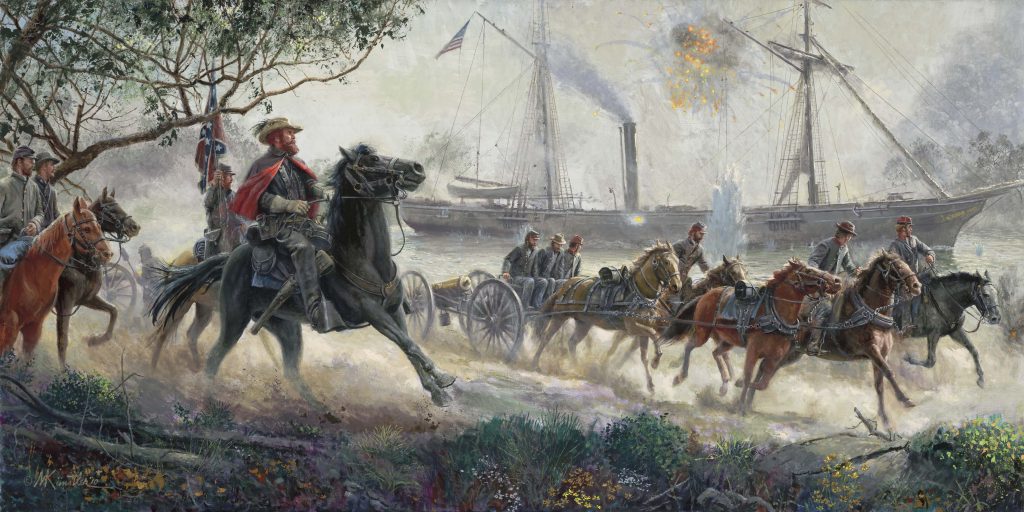
Throughout the year, Pelham often slipped away with one or two guns and those crews with orders or permission to harry the Union troops. His rapid movements, frequent location changes, and fast-paced firing became signatures of his artillery style. Pelham never lost a cannon in battle, and usually his casualty losses were minimal due to the frequent position changes which made it difficult for Union guns to fire back with accuracy.
Promoted to major in mid-August 1862, Pelham operated with Stuart through the summer. In the Second Manassas Campaign, though, he started working closely with General Jackson. Surprisingly, Jackson – who rarely took “unknown” officers into his confidence – entrusted right flank defense to Pelham and later gave him permission to go anywhere on the Manassas battlefield to provide artillery support. Pelham repaid the confidence with successes, helping to save Jackson’s ambulances and wagon train at Groveton, backing up A.P. Hill’s men, and finally pursuing the Union army to the fields of Chantilly and beyond.
During the Antietam Campaign, Pelham moved with Stuart, then joined General Hill to defend South Mountain. He employed delaying tactics through Keedysville, slowing the Union advance and gaining time for the Confederates to assemble at Sharpsburg. Stuart and Jackson posted Pelham’s batteries – which now included Chew’s Battery and sometimes other artillery additions – on the Second Corps far left flank, Nicodemus Hill. Here, Pelham directed hot artillery fire on Union General Hooker’s men advancing to the attack and dueled with Henry J. Hunt’s big guns. Startlingly, neither Jackson nor Stuart supervised this young commander, who had just turned twenty-four earlier that month, leaving him to make important decisions about flank defense. Jackson did send Pelham more cannon, and eventually, he had nineteen big guns to oversee at the Battle of Antietam. Endangered on Nicodemus Hill, Pelham pulled the artillery batteries back to Hauser Ridger (behind West Woods) and helped prevent a lasting break through in the Confederate lines near Dunker Church. Later on, he reoccupied Nicodemus Hill and tried to take the offensive toward the Union right flank but called off the mission when the enemy’s firepower was too strong.
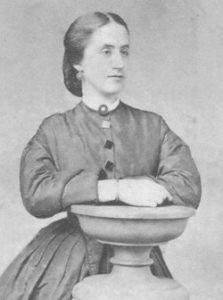
John Pelham’s promotion to major came through on September 22, 1862, and in the days following the retreat from Maryland, he and Stuart’s staff rested near the civilian home called “The Bower.” Here, with his new rank and growing confidence, Pelham started to emerge from the shadows in the evening gatherings, taking a more active part in the hilarity and entertainments at cavalry headquarters. Always shy and humble, he was an easy target for Stuart’s friendly teasing but joined in jokes and adventures with the Prussian officer, Heros Von Borcke. At The Bower, Pelham found a new interest beyond his guns and military friends: a serious girlfriend. Miss Sallie Dandridge and Major Pelham spent their spare time together, and by the time the cavalry left for the Chambersburg Raid, they were a couple, according to friends. Some accounts suggest, they were engaged to be married, and notes on their actions support the suggestion.
Stuart’s Chambersburg Raid and second ride around the Army of the Potomac brought new challenges for the horse artillery. The fast pace wore down the horses, and Pelham’s defense of the river fords ensured the cavalry’s crossing back to Virginia. In the later fall, Pelham said a final good-bye to Miss Dandridge, riding into battle again, fighting off Union attacks and probes ridge by ridge, giving the Confederate infantry time to cross the Blue Ridge Mountains and head east toward Fredericksburg. Moving quickly and firing faster, Pelham’s guns decimated the cavalry, infantry, and artillery sent against them, and Stuart heavily credited him in the battle report.
In the days before the Battle of Fredericksburg, Pelham harassed the Union ships at Port Royal on the south flank of the Confederate line. He also found time to hitch up the wagon and trot out to Chancellor House with other officers on the eve of battle for a country dance. Back on the battle lines and ready for a fight on December 13, 1862, Pelham asked Stuart if he could take a gun or two mid-field and fire on the advancing Union troops, headed for Jackson’s positions near Prospect Hill. Stuart agreed, trusting his younger officer’s judgment.
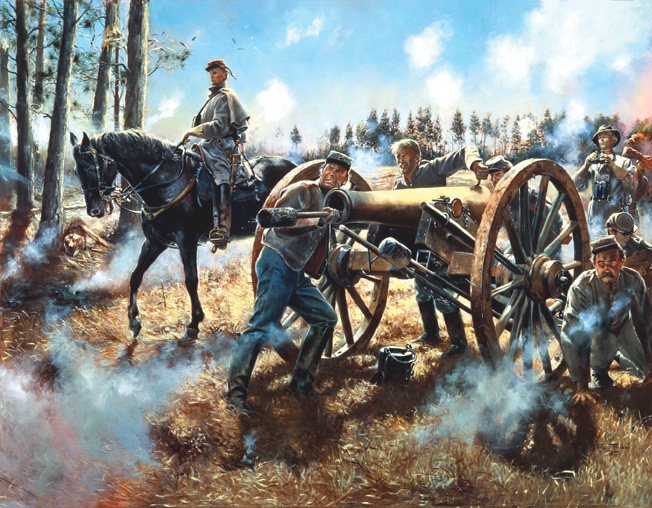
Positioned in a hollow, Pelham enfiladed the advancing Union soldiers. The storm of cannon shot and shell from Union artillery threatened Pelham’s position, drew admiration from Lee and Jackson, and terrified Stuart. Though Pelham’s men took heavily casualties than usual, their commander refused to withdraw until he had used all the ammunition, prompting Stuart to label him a “gallant fool.” When he finally returned, Jackson’s chief of artillery, Stapleton Crutchfield, loaned Pelham more artillery batteries, leaving the defense of Jackson’s flank to the younger artilleryman. Jackson begged Stuart to give him Pelham, saying according to legend, “With a Pelham on each flank, I could whip the world.” Stuart refused to give up his artilleryman, though, taking him on the Christmas Raid after a holiday dinner.
Winter quarters provided time to rest, repair, and retrain, and Pelham prepared his batteries for another season of heavy fighting. He had no idea that he prepared the units for someone else to command. Through a strange series of events, Pelham reported to J.E.B. Stuart at Culpeper on March 16, 1863, returning from inspecting and instructing an artillery battery near Orange. His own batteries were not at Culpeper, but he stayed the evening, visiting the friendly Shackelford family with the general and other officers.
The next morning – March 17, 1863 – the Battle of Kelly’s Ford exploded, catching the Confederate cavalry units by surprise. Pelham and Stuart headed for the fighting, and, at some point, Pelham departed to hurry along one of his batteries which was en route to the fighting. Captain James Breathed commanded this battery, and since he was Pelham’s long-time second-in-command and friend, the major gave a few hints and backed away, allowing Breathed to command. Unable to stay out of the fight, Pelham rallied with some cavalrymen for a charge. A Union artillery shell exploded above his location, and Pelham toppled from his horse as tiny fragments of the projectile rained down and pierced the back of his skull. Initially thought dead, Pelham still lived and was eventually hauled by horse and later ambulance to the Shackelford house in Culpeper. There, about twelve hours after his wounding, John Pelham died. In his dress uniform, his body lay in state in Richmond before it was taken to his family for burial in Jacksonville, Alabama. Posthumously, Pelham received promotion to Lieutenant Colonel.
John Pelham’s short life and military service reflects the challenges of the era. As a West Point cadet, he faced a serious and difficult decision. As a young officer, he seemed initially nervous to find his place and leadership role as he trained and commanded older men. As an artilleryman, he faced and rained death on numerous battlefields and skirmish grounds, reacting fearlessly until one day the shell fragments struck him.
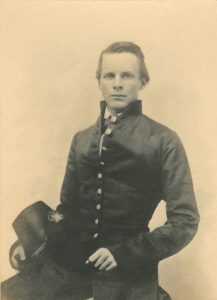 A comrade remembered Pelham, giving a glimpse of this young artilleryman as his friends knew him:
A comrade remembered Pelham, giving a glimpse of this young artilleryman as his friends knew him:
I never knew a human being of more stubborn nerve, or shrinking modesty… His color never faded in the hottest hours of the most desperate fighting but a word would often confuse him, and make him blush like a girl…it was impossible to know him and not love him… Quick to resent an insult, or to meet defiance with defiance, he was never irritable, and had the sweetness and good-humor of a child…. His modesty did not change after Fredericksburg…. He was still the modest, simply, laughing boy – with his charming gayety…his sunny smile. He never spoke of his own achievements.[iv]
His own achievements were many. Training raw recruits. Almost single-handedly organizing a light artillery battery. Dueling enemy batteries with unlikely odds. Driving back Union gunboats. Supervising flank defense for one of the most particular commanders in the Confederacy. Fearlessly dominating battlefields with foolish gallantry. Winning the admiration of superior officers in almost countless conflicts. John Pelham helped to reinvent light artillery, using his innovative ideas to score victories. The fast-moving, rapid fire tactics he employed were copied and expanded by others during the Civil War and in future conflicts. Though legendary, John Pelham did not seem to want the fame and glory. Humble almost to a fault, he started and ended his Confederate service as “a boy – a splendid boy”[v] who played with cannons, defied the odds, and filled pages of history that he never lived to read.
Sources:
Hassler, W.W. (1960). Colonel John Pelham: Lee’s Boy Artillerist. Chapel Hill, NC: The University of North Carolina Press.
**Maxwell, J.H. (2011). The Perfect Lion: The Life & Death of Confederate Artillerist John Pelham. Tuscaloosa, AL: The University of Alabama Press. (**Recommended Resource)
Mercer, P. (1929). The Life of Gallant Pelham. Kennesaw, GA: J.W. Burke Co. (Accessed at The Huntington Library, San Marino, California.)
[i] Hassler, W.W. (1960). Colonel John Pelham: Lee’s Boy Artillerist. Chapel Hill, NC: The University of North Carolina Press. (Page 254)
[ii] Ibid, Page 11
[iii] Ibid, see pages 39-44 for Pelham’s choice about secession.
[iv] Ibid, Page 272
[v] Ibid, Page 294; Bessie Shackelford quote
Excellent story — all new to me. Thanks! ….. George in Kitty Hawk
Glad you enjoyed it, George. If you’re looking for more information about Pelham, I’d recommend the 2011 biography listed in the sources; it was my favorite of all the ones I’ve read.
I’m a 4th cousin of the Gallant John Pelham, since his and my ancestors are descended from the Clay’s. I have all of the Biography Books that have been written about him so far. Starting with the book where he is mentioned on one page called Valor in Glory written by Greg Clemmer.
Thanks for posting this, I am always on the lookout for information on John Pelham, he was so unlucky meeting his end at Kelly’s Ford – he probably really need not have been there on that day, however from what I’ve read about Pelham there would have been no holding him back.It makes me wonder had he and Stonewall Jackson survived what impact the Army of Northern Virginia would have had on the outcome of the battle of Gettysburg, then again the Confederacy was taking a lot of major hits,(Jeb Stuart in 1864 and A. P Hill) dealt by the Union, on its roll of talented officers and troops Shelby Foote stated on ”The Civil War” by Ken Burns -” that the Union fought that war with one hand tied behind its back-if things got to the stage where the struggle got a bit tougher they would just increase their effort accordingly” or words to that effect. Pickett’s Charge and its defeat was the death blow that made victory finally out of reach for Robert E. Lee and the Confederacy. The Union also lost many talented and dedicated individuals, Alonzo Cushing, John Buford, to name only a couple.
,
I’m from Pelham’s neighbourhood and talked to his family in the 1960”s. They still had one of his pistols, a Colt navy, and they had given his other to a relative. The Colt they had was still loaded until a few years earlier, they gave it to a local man to unload it. I knew the man and when I asked what he did with the bullets, he said he threw them away. I would have loved to have had them.
John Carney, Bronx,NewYork
May12,2021
Very Informative, many items of his military history I wasn’t aware
of. Must have been tough to leave West Pt. before graduating &
forsaking his oath. I guess can’t fight against home and family.
Truly was an outstanding Art.officer& brave,gutsy young man.
Stuart must have felt his loss tremendously!
As a native of Jacksonville,Alabama I became interested in John Pelham at an early age after seeing his statue at the Jacksonville City Cemetery where he’s buried.He was a talented young man destined for greatness before his death at Kelly’s Ford.Major Pelham is still remembered by the citizens of Jacksonville and his ancestors still reside in Calhoun County.
I’m originally from Anniston and talked to the family back in the 1960’s. They had one of his Colt navy revolvers and another that was returned with his body another relative in Montgomery had. Both were still loaded and the charges were pulled at Worsham Lumber in Anniston. The family donated/loaned his sword to the State Archives and they got it mixed up with others and don’t know which it is. I offered to take pictures of all the possible swords and see it the family could identify it, but the curator went into a panic and didn’t want them to know it was lost.